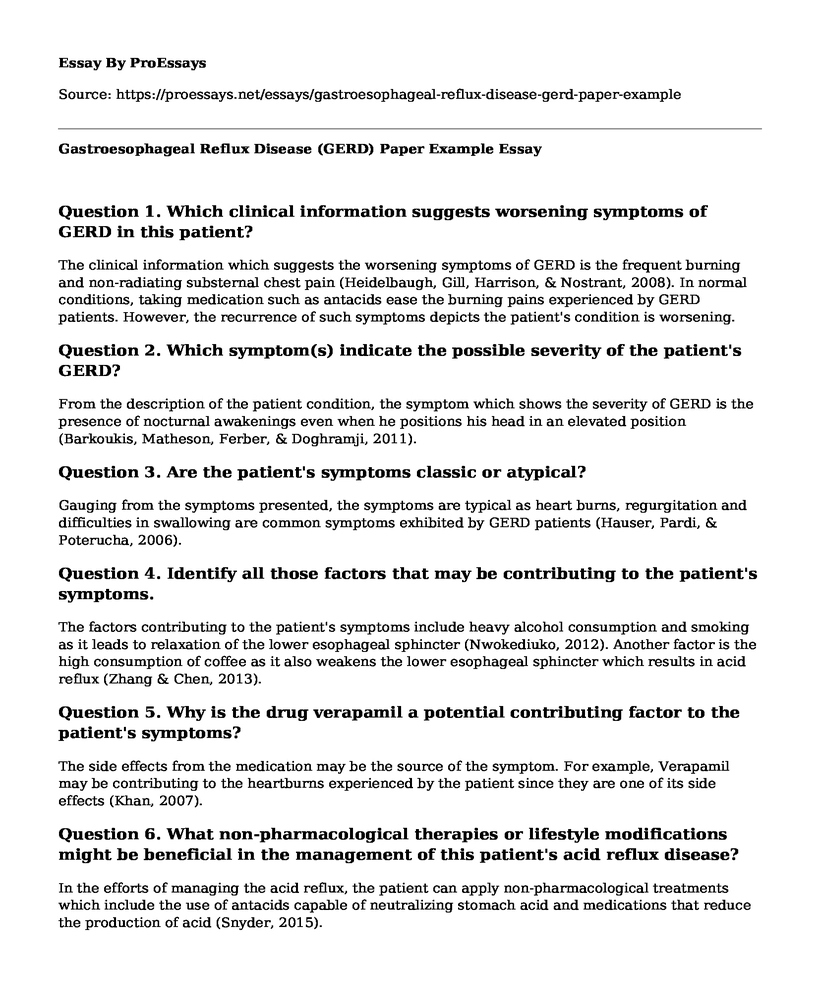Question 1. Which clinical information suggests worsening symptoms of GERD in this patient?
The clinical information which suggests the worsening symptoms of GERD is the frequent burning and non-radiating substernal chest pain (Heidelbaugh, Gill, Harrison, & Nostrant, 2008). In normal conditions, taking medication such as antacids ease the burning pains experienced by GERD patients. However, the recurrence of such symptoms depicts the patient's condition is worsening.
Question 2. Which symptom(s) indicate the possible severity of the patient's GERD?
From the description of the patient condition, the symptom which shows the severity of GERD is the presence of nocturnal awakenings even when he positions his head in an elevated position (Barkoukis, Matheson, Ferber, & Doghramji, 2011).
Question 3. Are the patient's symptoms classic or atypical?
Gauging from the symptoms presented, the symptoms are typical as heart burns, regurgitation and difficulties in swallowing are common symptoms exhibited by GERD patients (Hauser, Pardi, & Poterucha, 2006).
Question 4. Identify all those factors that may be contributing to the patient's symptoms.
The factors contributing to the patient's symptoms include heavy alcohol consumption and smoking as it leads to relaxation of the lower esophageal sphincter (Nwokediuko, 2012). Another factor is the high consumption of coffee as it also weakens the lower esophageal sphincter which results in acid reflux (Zhang & Chen, 2013).
Question 5. Why is the drug verapamil a potential contributing factor to the patient's symptoms?
The side effects from the medication may be the source of the symptom. For example, Verapamil may be contributing to the heartburns experienced by the patient since they are one of its side effects (Khan, 2007).
Question 6. What non-pharmacological therapies or lifestyle modifications might be beneficial in the management of this patient's acid reflux disease?
In the efforts of managing the acid reflux, the patient can apply non-pharmacological treatments which include the use of antacids capable of neutralizing stomach acid and medications that reduce the production of acid (Snyder, 2015).
Question 7. What pharmaceutical alternatives are available for the treatment of this patient's GERD?
The patient can use pharmacological treatment options which include antisecretory therapy such as proton pump inhibitors and H2 receptor antagonists' therapies (Hauser, Pardi, & Poterucha, 2006).
Question 8. What therapeutic options are now available for this patient?
One of the therapeutic options is the ambulatory pH monitoring as it allows direct determination of the frequency for the reflux episode and the link between the reflux episodes and the symptoms (Badillo & Francis,2014). Another option is the surgical therapy which offers a therapy of a long-term nature.
Question 9. Based on upper endoscopy test results, what grades of esophagitis can be assigned to this patient's condition?
Based on the test results on the upper endoscopy, the patient's condition can be assigned to grade D esophagitis. From the results of the endoscopy, the patient exhibits circular, confluent multiple erosions on the esophagus which are symptoms for grade D esophagitis (Ragunath, 2013).
References
Badillo, R., & Francis, D. (2014). Diagnosis and treatment of gastroesophageal reflux disease. World journal of gastrointestinal pharmacology and therapeutics, 5(3), 105-12.
Barkoukis, T. J., Matheson, J. K., Ferber, R., & Doghramji, K. (2011). Therapy in Sleep Medicine E-Book. Philadelphia: Saunders.
Hauser, C., Pardi, D., & Poterucha, J. (2006). Mayo Clinic gastroenterology and hepatology board review. Boca Raton: CRC Press.
Heidelbaugh, J., Gill, A., Harrison, R., & Nostrant, T. (2008). Atypical presentations of gastroesophageal reflux. Am Fam Physician, 78(4),483-488.
Khan, M. G. (2007). Cardiac Drug Therapy. Totowa, NJ: Humana Press Inc.
Nwokediuko, S. (2012). Current trends in the management of gastroesophageal reflux disease: A review. ISRN Gastroenterology, 2012, 391631.
Ragunath, S. (2013). The los Angeles classification of gastroesophageal reflux disease. Video Journal and Encyclopedia of GI Endoscopy, 1(1), 103-104.
Snyder, J. S. (2015). Pharmacology and the nursing process. Amsterdam: Elsevier - Health Sciences Div.
Zhang, Y., & Chen, S. (2013). Effect of coffee on gastroesophageal reflux disease. Food Sci. Technol. Res., 19(1), 1-6.
Cite this page
Gastroesophageal Reflux Disease (GERD) Paper Example. (2022, Sep 26). Retrieved from https://proessays.net/essays/gastroesophageal-reflux-disease-gerd-paper-example
If you are the original author of this essay and no longer wish to have it published on the ProEssays website, please click below to request its removal:
- The Role of Culture in Health Communication Post Reflection Paper
- Essay Example on Women's Health: Ensuring Non-Discriminatory Care & Accessibility
- Paper Example on Providing Competent Client-Centered Care: Mrs. G's Case
- Nutrition: A Crucial Factor in Good Health and Why People Fail in It - Essay Sample
- Essay Example on Gut Microbiome and Allergic Disease: A Link?
- Essay Example on COVID-19: Online Learning Brings New Opportunities for Colleges & Universities
- Paper Example on Health Benefits of Walking for Older Adults: A Limited-Bias Study







